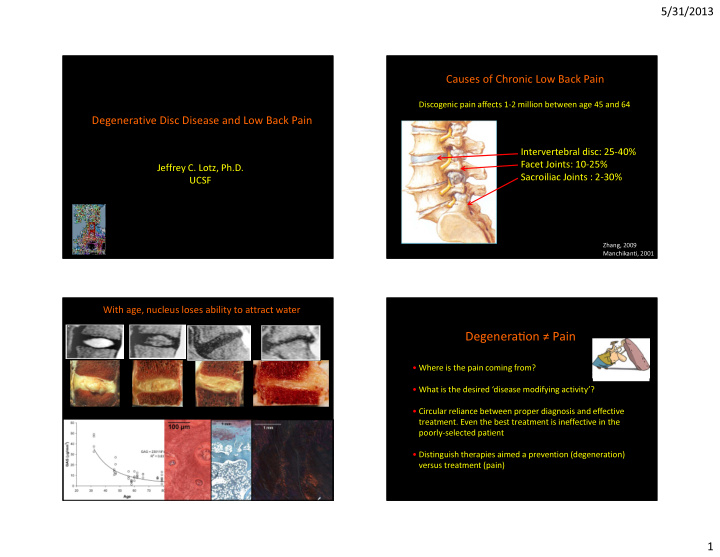



5/31/2013 Causes of Chronic Low Back Pain Discogenic pain affects 1-2 million between age 45 and 64 Degenerative Disc Disease and Low Back Pain Intervertebral disc: 25-40% Facet Joints: 10-25% Jeffrey C. Lotz, Ph.D. Sacroiliac Joints : 2-30% UCSF Zhang, 2009 Manchikanti, 2001 With age, nucleus loses ability to attract water Degenera�on ≠ Pain • Where is the pain coming from? • What is the desired ‘disease modifying activity’? • Circular reliance between proper diagnosis and effective Grade I Grade III Grade IV Grade V treatment. Even the best treatment is ineffective in the poorly-selected patient • Distinguish therapies aimed a prevention (degeneration) versus treatment (pain) 1
5/31/2013 Innervation of Annulus Fibrosus ‘For any structure to be deemed a cause of back pain it should have a nerve supply, and be capable of causing pain similar to that seen clinically…’ Bogduk, 1997 Outer Disc Boundaries Contain Both Nociceptive and Proprioceptive Nerve Fibers Grey Ramus Sinuvertebral Nerve Cavanaugh et al., 1997 Fagan et al., 2003 Sympathetic Trunk Bogduk, 1983 Bogduk, 1981 Innervation of the Vertebral Endplate Neo-innervation Balance Between Repulsion and Attraction Pressure Neurotrophins Matrix - Impermeability, Proteoglycan (NGF, BDNF) ‘Arterial Grid’ Crock, 1986 Bailey et al, 2010 2
5/31/2013 Annular Pain – Internal Disc Disruption Peripheral disc damage plus increased inflammation can sensitize nociceptors Fissures Extend to the Outer 30% of annulus Secondary inflammation with neovascularization appears as a HIZ During inflammation, nociceptors can fire at lower thresholds Crock, 1986 Ozaktay et al., 1995 April, 1992 Cavanaugh, 1996 Peng, 2005 Endplate Defects Trigger Fibrovascular Marrow Fibrovascular Marrow is Innervated PGP9.5 Immunolocalization EP cartilage Subchondral bone Crock, 1986 Ohtori , 2006 Rahme, 2008 Degmetich, 2011 Degmetich, 2011 3
5/31/2013 Endplates are more innervated in regions of damage Modes of endplate damage Endplate damage is more innervated than annular damage Lotz, 2013 Fields, 2012 Cascade of Degeneration and Damage Endplate Damage is Hard to Visualize with Standard MRI Leads to Neo-innervation DRG Nucleus is Pro-inflammatory Ma, 2011 A B Lee, 2011 Injury – Inflammation – Cytokine secretion (IL-1 β , TNF- α ) NGF secretion – retrograde to DRG NGF acts on TrkA-neurons – growth + SP, CGRP Matrix damage + chemical sensitization – Pain Garcia-Cosamalon, 2010 4
5/31/2013 Summary Summary • Degeneration by it self is non-painful • Degeneration by it self is non-painful • Nucleus pulposus is pro-inflammatory • Nucleus pulposus is pro-inflammatory • Peripheral disc damage (of endplate or annulus) can: • Peripheral disc damage (of endplate or annulus) can: 1) trigger neo-innervation; 1) trigger neo-innervation; 2) chemical sensitization; and 2) chemical sensitization; and 3) mechanical irritation 3) mechanical irritation • Mechanical irritation plus chemical sensitization can • Mechanical irritation plus chemical sensitization can cause pain cause pain Summary Summary • Degeneration by it self is non-painful • Degeneration by it self is non-painful • Nucleus pulposus is pro-inflammatory • Nucleus pulposus is pro-inflammatory • Peripheral disc damage (of endplate or annulus) can: • Peripheral disc damage (of endplate or annulus) can: 1) trigger neo-innervation; 1) trigger neo-innervation; 2) chemical sensitization; and 2) chemical sensitization; and 3) mechanical irritation 3) mechanical irritation • Mechanical irritation plus chemical sensitization can • Mechanical irritation plus chemical sensitization can cause pain cause pain 5
5/31/2013 Summary • Degeneration by it self is non-painful • Nucleus pulposus is pro-inflammatory • Peripheral disc damage (of endplate or annulus) can: 1) trigger neo-innervation; 2) chemical sensitization; and 3) mechanical irritation AR052712 Thank You AR052811 • Mechanical irritation plus chemical sensitization can AR049786 Jeannie Bailey cause pain Ellen Liebenberg Aaron Fields • Need better imaging techniques to identify areas of innervated damage The Vertebral Endplate is also a source of pain • Endplate is ‘weak link’ during spinal compression Adams, 2000; Gallagher, 2005 • Endplate innervation is increased in discogenic pain patients Freemont, 2002: Brown, 1997 • Endplates deflect during discography, elevated interosseus pressure can cause pain Heggeness, 1993; Esses, 1992 • BML is one of the most specific MRI finding for discography-confirmed discogenic pain Braithwaite, 1998; Weishaupt, 2001 6
Recommend
More recommend